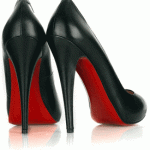In 1992, shoemaker Christian Louboutin began using red lacquer soles on some of its shoes. In 2008, the red soles were registered as mark in the US Patent and Trademark Office, and on January 1, 2008, number 3, 361,597, the “red sole mark” came to life.
In 2012 Louboutin sued Yves St. Laurent (“YSL”). They were seeing red (pun intended) over the recent Yves St. Laurent 2011 Resort collection, which included red-soled shoes, the Louboutin signature brand detail. Louboutin filed a trademark action against YSL, which YSL prominently countered with a counter-suit seeking cancellation of the Louboutin trademark registration. Louboutin responded with a request for a preliminary injunction temporarily preventing YSL from selling the shoes until the dispute was settled. The district court initially denied Loboutin’s request largely on the basis that . . .”in the fashion industry color serves ornamental and aesthetic functions vital to robust competition . . . However, “Color alone “ sometimes ” may be protectable as a trademark, “where that color has attained ‘secondary meaning’ and therefore identifies and distinguishes a particular brand (and thus indicates its ‘source’).” Conversely, color may not be protectable where it is “functional,” meaning that the color is essential to the use or purpose of the product, or affects the cost or quality of the product.”
Affirming in part and reversing in part, the 2nd circuit stated that
We conclude that the District Court’s holding that a single color can never serve as a trademark in the fashion industry, Christian Louboutin S.A. v. Yves Saint Laurent America, Inc., 778 F.Supp.2d 445, 451, 457 (S.D.N.Y.2011) (“Louboutin”), is inconsistent with the Supreme Court’s decision in Qualitex Co. v. Jacobson Products Co., 514 U.S. 159, 162, 115 S.Ct. 1300, 131 L.Ed.2d 248 (1995) (“Qualitex ”), and that the District Court therefore erred by resting its denial of Louboutin’s preliminary injunction motion on that ground. We further conclude that Louboutin’s trademark, which covers the red, lacquered outsole of a woman’s high fashion shoe, has acquired limited “secondary meaning” as a distinctive symbol that identifies the Louboutin brand. As explained below, pursuant to Section 37 of the Lanham Act, 15 U.S.C. § 1119, we limit the trademark to uses in which the red outsole contrasts with the remainder of the shoe (known as the “upper”). We conclude that the trademark, as thus modified, is entitled to trademark protection. Finally, we conclude that, because the monochrome design employed by YSL is not a use of Louboutin’s modified trademark, we need not, and indeed should not, address whether YSL’s use of a red outsole risks consumer confusion or whether the Louboutin mark, as modified, is “functional.”
In short, the Circuit Court rejected the District courts argument that that clothes are inherently aesthetic, and that the addition of an aesthetic feature like the color is merely a function of the design and therefore not protectable as a trademark, however found that the use of the color in this context has to be fairly limited.
While the red sole has become synonymous with Louboutin, with women paying $595- $1000 for a pair of these status symbol shoes, the ability to take an entire color off of the pallet of future designers would be far reaching and stifle the creativity contained in future catalogs and runways.
Thanks to Sara Harrison for her assistance with this post.
Edited 10/27/14
